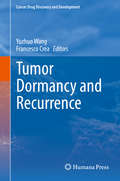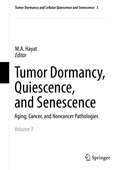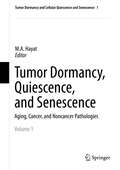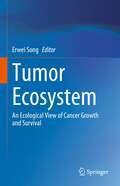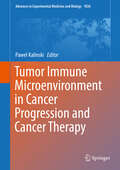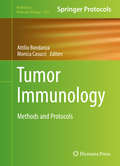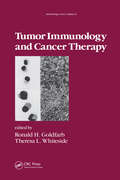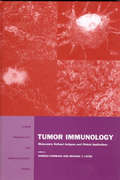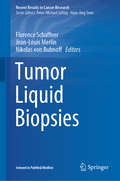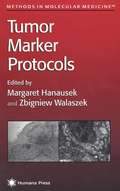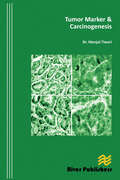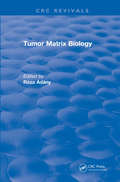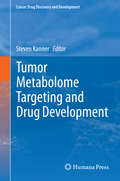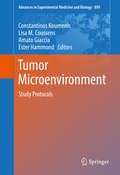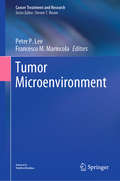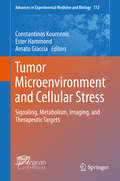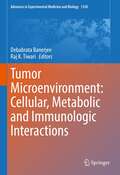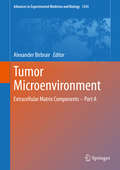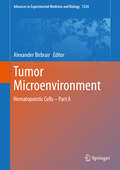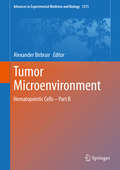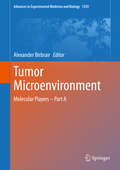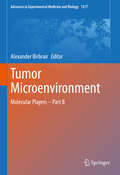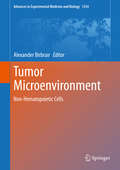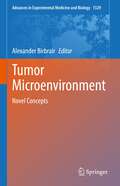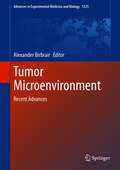- Table View
- List View
Tumor Dormancy and Recurrence
by Yuzhuo Wang Francesco CreaThis volume will be the first to provide a comprehensive description of tumor dormancy. It will define the clinical and biological aspects of this phenomenon, as well as the cellular and molecular mechanisms associated with tumor dormancy. Chapters will be authored by world-renewed experts who are conducting cutting-edge research in the field. A unique feature will be a conclusive paragraph detailing future development and foreseeable clinical applications at the end of each chapter. The volume will serve as a fundamental instrument for every researcher and clinician interested in the field of tumor dormancy as well as a means of disseminating stimulating concepts and prompting the development of innovative technological solutions.
Tumor Dormancy, Quiescence, and Senescence, Vol. 3
by M. A. HayatThis third volume in the series Tumor Dormancy, Quiescence, and Senescence discusses the role of tumor dormancy and senescence in a number of diseases, including breast cancer, ovarian cancer and leukemia. The contents are organized under five subheadings: General Applications, Role in Breast Cancer, Role in Ovarian Cancer, Role in Leukemia and Role in Cardiovascular Disease. The first section includes basic information on the definition of dormancy, how cells become senescent and what they do, along with an appraisal of the current state of research on dormancy. Section Two explores dormancy in breast cancer, including the progression of hormone-dependent mammary tumors after dormancy. Section Three details the resistance of Type II ovarian tumors, in which the resistant tumor cell population persists after chemotherapy in a state of dormancy, with recurrent tumors arising upon transformation of such dormant cells back to malignant growth. This section explains how lineage, histological subtypes and grade influence the differential response of ovarian cancer resistance to platinum drugs. The fourth section explores leukemia, discussing regulation of the promyelocytic leukemia protein and its role in premature senescence. The final section explores the role of senescence and autophagy in age-related cardiovascular diseases and the observation that autophagy seems to retard cardiac senescence. Like the two preceding volumes in the series, Volume 3 stands out for its comprehensive approach, its roster of some 26 expert contributors representing seven different countries and its up-to-date review of leading-edge technology and methods.
Tumor Dormancy, Quiescence, and Senescence, Volume 2
by M. A. HayatIn this second volume in the series exploring Tumor Dormancy, Quiescence, and Cellular Senescence, discussion is focused on the role of tumor dormancy in diseases such as breast cancer, melanoma, prostate cancer, liver cancer and lung cancer. M. A. Hayat, the series editor, writes in the preface that little is known of factors regulating the transition of residual cancer into a dormant state or the subsequent reinitiation of growth. A majority of us, he says, have in situ tumors that may remain dormant or may progress into a lethal form of cancer; the former are prevented from recruiting their own blood supply. Section I covers Molecular Mechanisms, with chapters on the role of NAE inhibitor MLN4924; oncogene-induced senescence; the role played by mitogen-activated protein kinase in the induction of cellular senescence; mechanisms of premature cell senescence and other topics. Section II examines Tumor and Cancer, discussing defects in chromatin structure and diseases; the role of fibrosis in tumor progression and the dormant to proliferative switch; the function of ING proteins in cancer and senescence and more. The final section is devoted to Stem Cells and Cancer Stem Cells, featuring chapters showing that senescent-derived pluripotent stem cells are able to redifferentiate into fully rejuvenated cells; that the transcription factor Gata2 regulates quiescence in haematopoietic stem and progenitor cells; and discussing dormancy and recurrence of cancer stem cells in bone. The contributors point out that the quiescent state regulates hematopoietic stem cells and muscle stem cells, and detail the role of kinase in the mediation of reversible quiescent state in a subset of ovarian, pancreatic, and colon cancers. Molecular mechanisms underlying stress-induced cellular senescence and accumulation of reactive oxygen species and induction of premature senescence are also presented. Discussion includes the important role of microRNAs in oxidative stress-induced apoptosis and senescence and the effect of microRNA as a modulator of cell proliferation in lung cancer. The book includes an explanation of the suppression of cellular senescence in glioblastoma brain tumor. Taking a broad and varied perspective, this volume was written by 70 contributors representing 11 countries.
Tumor Ecosystem: An Ecological View of Cancer Growth and Survival
by Erwei SongThis book intends to report new concept of onco-spheres in cancer ecosystem. Onco-spheres are defined as where cancer cells (living organisms) dynamically interact with nontumor cellular (other living organisms) and noncellular components (non-living environmental factors) in the ‘host’ internal environment (habitat) to construct a self-sustainable cancer ecosystem, which can be scoped at three different levels: primary/regional, distal and systemic onco-spheres. Cancer cells should be conceived as ‘living organisms’, interacting with cellular or noncellular components in the host internal environment, not only with the local tumor microenvironment (TME) but also constantly communicating with a distant organ niche as well interacting with the host’s nervous, endocrine and immune systems, to construct a self-sustainable ‘biosphere’, as we termed the tumor ecosystem. By looking at the interaction of cancer and host as a unique ecosystem, we will use ecology principles to further delineate the features of the dynamics of the tumor ecosystem. As the pioneer in proposing this concept, we feel that this full-scale overview of the tumor ecosystem is able to inform the readers about this concept, and to pave the way for designing novel therapeutic strategies on actionable targets within tumor ecosystem. The book is likely to be of interest to immunologist, biologist, medical students, researchers and general public who wish to learn more on this new concept of tumor ecosystem, and how this could be applied in many fields of research.
Tumor Immune Microenvironment in Cancer Progression and Cancer Therapy (Advances in Experimental Medicine and Biology #1036)
by Pawel KalinskiThe tumor microenvironment has become a very important and hot topic in cancer research within the past few years. The tumor microenvironment is defined as the normal cells, molecules, and blood vessels that surround and feed a tumor cell. As many scientists have realized, studying the tumor microenvironment has become critical to moving the field forward, since there are many players in a tumor’s localized and surrounding area, which can significantly change cancer cell behavior. There is a dual relationship wherein the tumor can change its microenvironment and the microenvironment can affect how a tumor grows and spreads. Tumor Microenvironment in Cancer Progression and Cancer Therapy aims to shed light on the mechanisms, factors, and mediators that are involved in the cancer cell environment. Recent studies have demonstrated that in addition to promoting tumor progression and protecting tumor cells from the spontaneous immune-mediated rejection and different forms of cancer therapeutics, tumor microenvironment can also be a target and mediator of both standard and newly-emerging forms of cancer therapeutics. Thus, the dual role of the tumor microenvironment is the integral focus of the volume. The volume highlights the bi-directional interactions between tumor cells and non-malignant tumor component during tumor progression and treatment. It also focuses on the three groups of the reactive tumor component: stromal cells, blood vessels and the infiltrating immune cells. These three groups are discussed under the lens of their role in promoting tumor growth, shielding the tumor from rejection and from standard forms of cancer therapies. They are emerging as targets and mediators of standard and new forms of potential therapy.
Tumor Immunology
by Attilio Bondanza Monica CasucciThis volume explores the still undiscovered secrets of tumor immunology and cancer immunology by discussing the methods and techniques that world-renowned experts in the field use in their laboratories. This book provides a better understanding of the rules governing tumor and cancer immunology, and discusses innovations in the technology of the immunological "smart bullets" (monoclonal antibodies, vaccines, tumor-reactive T cells) used to specifically target cancer cells. Written in the highly successful Methods in Molecular Biology series format, chapters include introductions to their respective topics, lists of the necessary materials and reagents, step-by-step, readily reproducible laboratory protocols, and tips on troubleshooting and avoiding known pitfalls. Thorough and cutting-edge, Tumor Immunology: Methods and Protocols contains a wide breadth of subject coverage that any scientist, clinician, or industry professional interested in this field will find valuable.
Tumor Immunology and Cancer Therapy
by R. H. GoldfarbBased on a Tumor Immunology Symposium held in Pittsburgh, this work provides comprehensive coverage of the most important aspects of tumor immunology. It reveals novel approaches to the immunotherapy of cancer and presents complex issues in an accessible manner.
Tumor Immunology: Molecularly Defined Antigens and Clinical Applications
by Giorgio Parmiani Michael T. LotzeRecent advances in immunology and molecular biology have resulted in new therapeutic approaches being generated and implemented in cancer clinics. The discovery of new antigens, mechanisms of antigen presentation, and interplay of cells involved in anti-tumor immunity have made the clinical control of some cancers more plausible than previously tho
Tumor Liquid Biopsies (Recent Results in Cancer Research #215)
by Florence Schaffner Jean-Louis Merlin Nikolas Von BubnoffThis book is a comprehensive guide to the techniques, clinical applications, and benefits of the different forms of liquid biopsy employed in patients with a variety of tumor types, including lung, breast and colorectal cancer. Offering detailed explanations, it discusses the how changes in tumors can be tracked using these cutting-edge technologies, which enable the detection and analysis of diverse circulating biomarkers: tumor cells, tumor DNA, tumor RNA (free or in exosomes), and fluid biomarkers identifiable by means of targeted proteomics. The use of such advanced technologies is enabling us to tackle questions and problems in a way that was not possible just a few years ago. We now have at our disposal an effective means of overcoming the problem of intratumor heterogeneity, which has limited the value of conventional biopsy approaches. As a consequence, oncology practice is about to change radically, toward truly personalized precision medicine. This book provides both clinicians and researchers with a thorough and up-to-date overview of progress in the field.
Tumor Marker Protocols
by Zbigniew Walaszek Margaret HanausekA much-needed collection of cutting-edge methods for the detection and discovery of new cancer markers, particularly molecular tumor markers. Each method is fully described by a hands-on expert who regularly uses it in the laboratory and has perfected it to a high degree of ready reproducibility. Special emphasis is given to statistical considerations in the analysis of tumor markers, recent discoveries in the field of serum and tissue marker proteins, cytogenetic markers, molecular markers, and markers for the early detection of cancer. The well-honed procedures detailed here will enable cancer researchers and clinical oncologists alike to realize the promise of these powerful new diagnostic strategies for the detection, therapy, and successful prevention of cancer.
Tumor Marker and Carcinogenesis
by Manjul TiwariCancer may be regarded as a group of diseases characterized by an (i) abnormal growth of cells (ii) ability to invade adjacent tissue and even distant organs and(iii) the eventual death of the affected patient if the tumor has progressed beyond that stage when it can be successfully removed.
Tumor Matrix Biology (CRC Press Revivals)
by Roza AdanyThis book would like to present the latest findings on different aspects of tumor matrix formation in connection with the tumor progression and metastasis and on alterations in the cellular components of tumor stroma during tumor demarcation and invasion.
Tumor Metabolome Targeting and Drug Development
by Steven KannerIn this volume, the major metabolic alterations identified in cancer and tumor-associated cells are explored, including discussions of former and emerging approaches to drug development in targeting cancer cell metabolism. The metabolic network in cells promotes the generation of both energy and biomass needed for them to grow, divide and differentiate. However, the metabolism of malignant cells generally varies from that of normal cells. These differences provide a platform for the discovery of new approaches to targeting potential vulnerabilities in cancer cells for therapeutic options Some of the significant changes that occur involve ATP production and consumption that modulates the ATP to ADP ratio, hypoxia and the effects of reactive oxygen species on glycolysis, regulation of mitochondrial respiration, induction and suppression of autophagy, and the Warburg effect and "reverse" Warburg effect--these topics and more are discussed in this volume.
Tumor Microenvironment
by Constantinos Koumenis Ester Hammond Amato Giaccia Lisa M. M. CoussensThis volume covers the topics presented at the 3rd International Conference on Tumor Microenvironment and Cellular Stress by an international community of researchers. The conference brings together scientists to discuss different cellular and animal models of tumor microenvironment study and identify common pathways that are candidates for therapeutic intervention; stimulate collaboration between groups that are more focused on elucidation of biochemical aspects of stress biology (e. g. , HIF regulation) and groups that study the pathophysiological aspects of stress pathways or engaged in drug discovery; and critically evaluate novel targets for imaging or therapeutic intervention that would be of use to the tumor microenvironment community and pharmaceutical industry.
Tumor Microenvironment (Cancer Treatment and Research #180)
by Francesco M. Marincola Peter P. LeeThis book addresses the biological processes relevant to the immune phenotypes of cancer and their significance for immune responsiveness, based on the premise that malignant cells manipulate their surroundings through an evolutionary process that is controlled by interactions with innate immune sensors as well as the adaptive recognition of self/non-self. Checkpoint inhibitor therapy is now an accepted new form of cancer treatment. Other immuno-oncology approaches, such as adoptive cell therapy and metabolic inhibitors, have also shown promising results for specific indications. Immune resistance is common, however, limiting the efficacy of immunotherapy in many common cancer types. The reasons for such resistance are diverse and peculiar to the immune landscapes of individual cancers, and to the treatment modality used. Accordingly, approaches to circumvent resistance need to take into account context-specific genetic, biological and environmental factors that may affect the cancer immune cycle, and which can best be understood by studying the target tissue and correlated systemic immune markers. Understanding the major requirements for the evolutionary process governing human cancer growth in the immune-competent host will guide effective therapeutic choices that are tailored to the biology of individual cancers.
Tumor Microenvironment and Cellular Stress
by Constantinos Koumenis Ester Hammond Amato GiacciaThe collection of chapters in this proceeding volume reflects the latest research presented at the Aegean meeting on Tumor Microenvironment and Cellular Stress held in Crete in Fall of 2012. The book provides critical insight to how the tumor microenvironment affects tumor metabolism, cell stemness, cell viability, genomic instability and more. Additional topics include identifying common pathways that are potential candidates for therapeutic intervention, which will stimulate collaboration between groups that are more focused on elucidation of biochemical aspects of stress biology and groups that study the pathophysiological aspects of stress pathways or engaged in drug discovery.
Tumor Microenvironment: Cellular, Metabolic and Immunologic Interactions (Advances in Experimental Medicine and Biology #1350)
by Debabrata Banerjee Raj K. TiwariOver the past decade, the tumor microenvironment has become one of the most important research areas in cancer biology, as cells within the tumor microenvironment, despite being outnumbered by healthy cells, are able to evade surveillance and immune-mediated destruction. While researchers have learned a great deal about the cellular and structural makeup of the tumor microenvironment, there has been a growing understanding of the metabolic interplay between the tumor micronenvironment’s various cellular constituents and how each of them contributes to overall tumor growth and metastases. This new volume will guide researchers, students, oncologists and academics through a rapidly developing and changing field with a thorough understanding of tumor microenvironment biology from a cellular, structural, metabolic, and immunological perspective.
Tumor Microenvironment: Extracellular Matrix Components – Part A (Advances in Experimental Medicine and Biology #1245)
by Alexander BirbrairRevealing essential roles of the tumor microenvironment in cancer progression, this volume focuses on the extracellular matrix components of the tumor during cancer development. Further, it teaches readers about the roles of distinct constituents of the tumor microenvironment and how they affect cancer development. Topics include heparan sulphate, hyaluronan, fibronectin, perlecan, glypican, matrix metalloproteinases, and much more. Taken alongside its companion volumes, Tumor Microenvironment: Extracellular Matrix Components – Part A updates us on what we know about the different aspects of the tumor microenvironment, as well as apprises us on the future advances in the field. For the newest generation of researchers, this volume serves as a useful introduction to the history of scientists’ focus on the tumor microenvironment, and explores how this knowledge is currently applied in cancer treatments. The book is an essential text for advanced cell biology and cancer biology students, as well as for scientists seeking an update on the developments in tumor microenvironment research.All of the chapter authors are renowned international experts in the field of cancer biology, and in the specific subfields that are the focus of their chapters.
Tumor Microenvironment: Hematopoietic Cells – Part A (Advances in Experimental Medicine and Biology #1224)
by Alexander BirbrairRevealing essential roles of the tumor microenvironment in cancer progression, this book focuses on the role of hematopoietic components of the tumor microenvironment. Further, it teaches readers about the roles of distinct constituents of the tumor microenvironment and how they affect cancer development. Topics include neutrophils, basophils, T helper cells, cytotoxic lymphocytes, fibrocytes, and myeloid-derived suppressor cells, and more.Taken alongside its companion volumes, these books update us on what we know about various aspects of the tumor microenvironment as well as future directions. Tumor Microenvironment: Hematopoietic Cells – Part A is essential reading for advanced cell biology and cancer biology students as well as researchers seeking an update on research in the tumor microenvironment.
Tumor Microenvironment: Hematopoietic Cells – Part B (Advances in Experimental Medicine and Biology #1273)
by Alexander BirbrairRevealing essential roles of the tumor microenvironment in cancer progression, this book focuses on the role of hematopoietic components of the tumor microenvironment. Further, it teaches readers about the roles of distinct constituents of the tumor microenvironment and how they affect cancer development. Topics include eosinophils, NK cells, γδ T cells, regulatory T Cells, Langerhans cells, hematopoietic stem cells, Mast cells, B cells and Microglia, and more. Taken alongside its companion volumes, Tumor Microenvironment: Hematopoietic Cells – Part B updates us on what we know about various aspects of the tumor microenvironment as well as future directions. This book is essential reading for advanced cell biology and cancer biology students as well as researchers seeking an update on research in the tumor microenvironment.
Tumor Microenvironment: Molecular Players – Part A (Advances in Experimental Medicine and Biology #1259)
by Alexander BirbrairThis book provides a comprehensive overview of the latest research on the molecular players in the tumor microenvironment, including Cathepsin D, galectins, iron, oxygen, Phospholipase D1, leptin, extracellular vesicles, and more. Taken alongside its companion volumes, these books update us on what we know about the tumor microenvironment as well as future directions. Tumor Microenvironment: Molecular Players – Part A is essential reading for advanced cell biology and cancer biology students as well as researchers seeking an update on research in the tumor microenvironment.
Tumor Microenvironment: Molecular Players – Part B (Advances in Experimental Medicine and Biology #1277)
by Alexander BirbrairThis book provides a comprehensive overview of the latest research on the molecular players in the tumor microenvironment, including MicroRNAs, estrogen, Caveolin-1, Nitric Oxide, RANK/RANKL signaling, , COX-2 Signaling, Renin–angiotensin system, and more. Taken alongside its companion volumes, Tumor Microenvironment: Molecular Players – Part B updates us on what we know about the tumor microenvironment, as well as future directions. This book is essential reading for advanced cell biology and cancer biology students as well as researchers seeking an update on research in the tumor microenvironment.
Tumor Microenvironment: Non-Hematopoietic Cells (Advances in Experimental Medicine and Biology #1234)
by Alexander BirbrairRevealing essential roles of the tumor microenvironment in cancer progression, this volume focuses on non-hematopoietic cells within the tumor microenvironment.Further, it teaches readers about the roles of distinct constituents of the tumor microenvironment and how they affect cancer development. Topics include fibroblasts, adipocytes, mesenchymal stem cells, stellate cells, and more. Taken alongside its companion volumes, Tumor Microenvironment: Non-Hematopoietic Cells updates us on what we know about the different aspects of the tumor microenvironment as well as future directions. Useful for introducing the newer generation of researchers to the history of how scientists focused in the tumor microenvironment and how this knowledge is currently applied for cancer treatments, it will be essential reading for advanced cell biology and cancer biology students as well as researchers seeking an update on research in the tumor microenvironment.All of the chapter authors are renowned international experts in the cancer biology field in specific subfields that will be the focus of their chapters.
Tumor Microenvironment: Novel Concepts (Advances in Experimental Medicine and Biology #1329)
by Alexander BirbrairThis volume discusses novel concepts in cancer biology, focusing on different factors that affect the tumor microenvironment. Topics covered include sex-based differences in the tumor microenironment, dormancy in the tumor microenvironment, the influence of obesity on the tumor microenvironment, and much more. Taken alongside its companion volumes, Tumor Microenvironment: Novel Concepts covers the latest research on various aspects of the tumor microenvironment, as well as future directions. Useful for introducing the newer generation of researchers to the history of how scientists studied the tumor microenvironment as well as how this knowledge is currently applied for cancer treatments, it will be essential reading for advanced cell biology and cancer biology students, as well as researchers seeking an update on research on the tumor microenvironment.
Tumor Microenvironment: Recent Advances (Advances in Experimental Medicine and Biology #1225)
by Alexander BirbrairThis volume discusses recent research advances in cancer biology, focusing on the role of the tumor microenvironment. Taken alongside its companion volumes, Tumor Microenvironment: Recent Advances covers the latest research on various aspects of the tumor microenvironment, as well as future directions. Useful for introducing the newer generation of researchers to the history of how scientists studied the tumor microenvironment as well as how this knowledge is currently applied for cancer treatments, it will be essential reading for advanced cell biology and cancer biology students, as well as researchers seeking an update on research on the tumor microenvironment.
